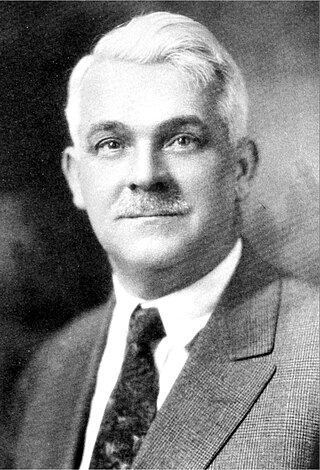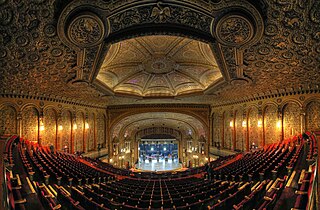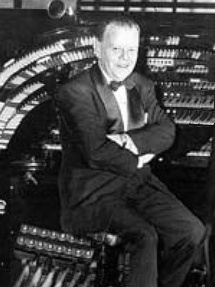
The Tennessee Theatre is a movie palace in downtown Knoxville, Tennessee. The theater was built in 1928 in the 1908 Burwell Building, considered Knoxville's first skyscraper. The theater and Burwell Building were added to the National Register of Historic Places in 1982, and the theater was extensively restored in the early 2000s. The Tennessee Theatre currently focuses on hosting performing arts events and classic films, and is home to the Knoxville Opera and the Knoxville Symphony Orchestra. The theater is managed by AC Entertainment.

C. W. & George L. Rapp, commonly known as Rapp & Rapp, was an American architectural firm famed for the design of movie palaces and other theatres. Active from 1906 to 1965 and based in Chicago, the office designed over 400 theatres, including the Chicago Theatre (1921), Bismarck Hotel and Theatre (1926) and Oriental Theater (1926) in Chicago, the Five Flags Center (1910) in Dubuque, Iowa and the Paramount Theatres in New York City (1926) and Aurora, Illinois (1931).

Thomas White Lamb was a Scottish-born, American architect. He was one of the foremost designers of theaters and cinemas of the 20th century.
The Paradise Theatre was a movie palace located in Chicago's West Garfield Park neighborhood. Its address was 231 N. Crawford Avenue, Chicago, Illinois. It was near the intersection of West Madison Street and Crawford in the West Garfield Park area of Chicago's West Side.

Shea's Performing Arts Center is a theater for touring Broadway musicals and special events in Buffalo, New York. Originally called Shea's Buffalo, it was opened in 1926 to show silent movies. It took one year to build the entire theatre. Shea's boasts one of the few theater organs in the US that is still in operation in the theater for which it was designed.

The Chicago Theatre, originally known as the Balaban and Katz Chicago Theatre, is a landmark theater located on North State Street in the Loop area of Chicago, Illinois. Built in 1921, the Chicago Theatre was the flagship for the Balaban and Katz (B&K) group of theaters run by A. J. Balaban, his brother Barney Balaban and partner Sam Katz. Along with the other B&K theaters, from 1925 to 1945 the Chicago Theatre was a dominant movie theater enterprise. Currently, Madison Square Garden, Inc. owns and operates the Chicago Theatre as a 3600 seat performing arts venue for stage plays, magic shows, comedy, speeches, sporting events and popular music concerts.

The Bay Theatre is a single-screen movie theater in Seal Beach, California, United States. It is best known for its screenings of foreign and independent films, and for its revival screenings. The Bay Theatre is also home to a Wurlitzer organ, which is used for concerts and silent film screenings.
George Wright was an American musician, possibly the most famous virtuoso of the theatre organ of the modern era.

The Paramount Theatre is a 2,807-seat performing arts venue located at 9th Avenue and Pine Street in the downtown core of Seattle, Washington, United States. The theater originally opened on March 1, 1928, as the Seattle Theatre, with 3,000 seats. It was placed on the National Register of Historic Places on October 9, 1974, and has also been designated a City of Seattle landmark.

The James M. Nederlander Theatre is a theater located at 24 West Randolph Street in the Loop area of downtown Chicago, Illinois. Previously known as the Oriental Theatre, it opened in 1926 as a deluxe movie palace and vaudeville venue. Today the Nederlander presents live Broadway theater and is operated by Broadway In Chicago, currently seating 2,253.

Jesse Crawford was an American pianist and organist. He was well known in the 1920s as a theatre organist for silent films and as a popular recording artist. In the 1930s, he switched to the Hammond organ and became a freelancer. In the 1940s, he authored instruction books on organ and taught organ lessons.

The Paramount Theatre is a concert venue in Denver, Colorado, located on Glenarm Place, near Denver's famous 16th Street Mall. The venue has a seating capacity of 1,870 but is a popular destination for large acts looking for a smaller concert setting. With spelling as Paramount Theater, the building was listed on the National Register of Historic Places in 1980.

Balaban and Katz Theater Corporation, or B&K, was a theatre corporation which owned a chain of motion picture theaters in Chicago and surrounding areas.

The United Palace is a theater at 4140 Broadway in the Washington Heights neighborhood of Manhattan in New York City. The theater, occupying a full city block bounded by Broadway, Wadsworth Avenue, and West 175th and 176th Streets, functions both as a spiritual center and as a nonprofit cultural and performing arts center. Architect Thomas W. Lamb designed the theater as a movie palace, which opened in 1930 as one of five Loew's Wonder Theatres in the New York City area. The theater's lavishly eclectic interior decor was supervised by Harold Rambusch, who also designed the interior of the Roxy Theatre and the Waldorf-Astoria Hotel.

The Brooklyn Paramount Theater is a former movie palace at 1 University Plaza at the intersection of Flatbush and DeKalb Avenues in downtown Brooklyn, New York. Opened in 1928, the building has been owned by Long Island University (LIU) since 1954. Converted for use by LIU as classroom space and a gymnasium, the building retains much of the theater's original decorative detail. Until recently the venue operated as a 1200-seat multi-purpose arena, formerly home to the Brooklyn Kings basketball team. As of 2017 it was in the planning stages of a renovation to reopen the theater as a performing arts venue in 2019.

1501 Broadway, also known as the Paramount Building, is a 33-story office building on Times Square between West 43rd and 44th Streets in the Theater District neighborhood of Manhattan in New York City. Designed by Rapp and Rapp, it was erected from 1925 to 1927 as the headquarters of Paramount Pictures. The building is designed in the Art Deco and Beaux-Arts styles. The office wing on Times Square contains numerous setbacks as mandated by the 1916 Zoning Resolution, while the rear wing housed the Paramount Theatre from 1926 to 1967. Newmark & Company owns 1501 Broadway.

Eugene De Rosa was an Italian American architect, called at birth Eugenio. He worked in New York City and specialized in the design of theatres.

The Rialto Theatre was a movie palace in New York City located at 1481 Broadway, at the northwest corner of Seventh Avenue and 42nd Street, within the Theater District of Manhattan.

Richard William "Dick" Leibert was an American musician who was the chief organist at New York City's Radio City Music Hall between 1932 and 1971. He also had a radio program of organ music on the NBC Radio Network in the 1930s and 1940s, along with making phonograph recordings on the RCA Victor and Westminster Records labels.




















